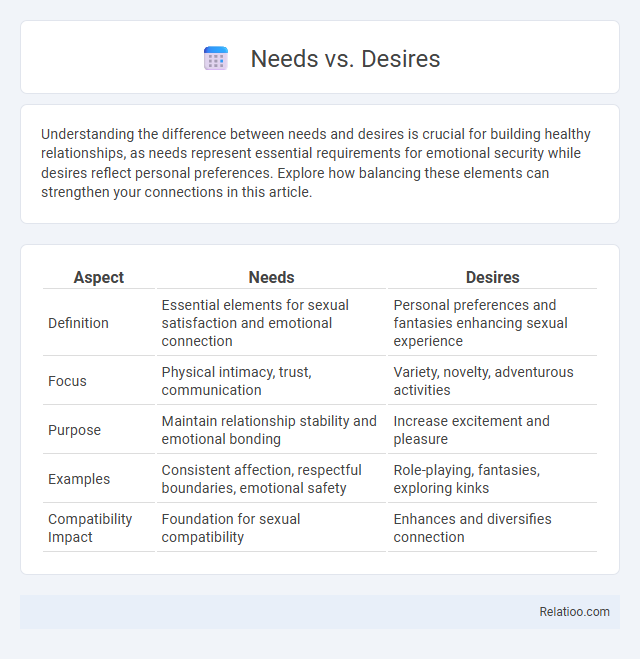Understanding the difference between needs and desires is crucial for building healthy relationships, as needs represent essential requirements for emotional security while desires reflect personal preferences. Explore how balancing these elements can strengthen your connections in this article.
Table of Comparison
| Aspect | Needs | Desires |
|---|---|---|
| Definition | Essential elements for sexual satisfaction and emotional connection | Personal preferences and fantasies enhancing sexual experience |
| Focus | Physical intimacy, trust, communication | Variety, novelty, adventurous activities |
| Purpose | Maintain relationship stability and emotional bonding | Increase excitement and pleasure |
| Examples | Consistent affection, respectful boundaries, emotional safety | Role-playing, fantasies, exploring kinks |
| Compatibility Impact | Foundation for sexual compatibility | Enhances and diversifies connection |
Understanding Needs and Desires
Understanding your needs and desires is crucial for fostering intimate conversations that build trust and emotional connection. Needs represent essential requirements for well-being, such as security and respect, while desires are shaped by personal preferences and deeper emotional yearnings. Clear communication about both helps partners align expectations and deepen their relationship satisfaction.
The Psychology Behind Needs and Desires
Understanding the psychology behind needs and desires reveals that needs are essential for survival and well-being, while desires are shaped by personal experiences and social influences. In intimate conversations, distinguishing between your true needs and fleeting desires fosters deeper connection and emotional honesty. Recognizing these differences improves communication and strengthens relational bonds by aligning expectations with authentic feelings.
Types of Human Needs
Human needs are categorized into physiological, safety, social, esteem, and self-actualization needs, each addressing different aspects of your well-being. Desires often stem from these needs but extend beyond basic survival to personal fulfillment and emotional satisfaction. Intimate conversations primarily satisfy social and esteem needs by fostering trust, connection, and validation between individuals.
Common Human Desires
Common human desires often revolve around connection, validation, and emotional intimacy, which transcend basic needs such as food, shelter, and safety. Intimate conversations play a crucial role in fulfilling these desires by fostering trust, vulnerability, and mutual understanding between individuals. Understanding the distinction between essential needs and psychological desires enhances relationship depth and personal fulfillment.
Needs vs Desires: Key Differences
Needs are essential for your survival and well-being, including food, shelter, and emotional security, while desires represent non-essential wants that enhance comfort or pleasure. Understanding the clear distinction between needs and desires is crucial in intimate conversations to avoid misunderstandings and ensure both partners feel valued and supported. Focusing on fulfilling core needs first creates a foundation of trust and genuine connection before addressing desires.
The Role of Culture in Shaping Needs and Desires
Culture profoundly influences the distinction between needs and desires, shaping what is considered essential versus optional in intimate conversations. Your cultural background dictates how emotional needs are expressed and which desires are socially acceptable, affecting communication dynamics in close relationships. Understanding these cultural nuances enables more meaningful and respectful intimate conversations, fostering deeper connection and empathy.
How Marketing Exploits Needs and Desires
Marketing strategically exploits the blurred lines between needs and desires to influence Your purchasing decisions by appealing to emotional triggers and perceived necessities. Brands craft intimate conversations that simulate personal connections, amplifying the emotional resonance of desires masked as essential needs. Understanding this dynamic empowers You to discern authentic needs from marketed desires, fostering more conscious consumption.
The Impact of Needs and Desires on Decision-Making
Your decision-making process is significantly influenced by the distinction between needs and desires. Needs represent essential requirements for well-being, while desires are driven by personal preferences and emotional impulses. Understanding how these factors interplay during intimate conversations can lead to clearer, more balanced choices that respect both practical necessities and emotional fulfillment.
Achieving Balance: Managing Needs and Desires
Achieving balance between needs and desires is essential for maintaining healthy intimate conversations and relationships. Clearly articulating fundamental needs such as trust, respect, and emotional security helps establish a stable foundation, while acknowledging desires allows for personal growth and deeper connection. Effective communication strategies like active listening and empathy enable partners to navigate conflicts and align expectations, fostering mutual understanding and satisfaction.
Needs and Desires in Personal Growth
Understanding the distinction between needs and desires is essential for your personal growth, as needs represent fundamental requirements for well-being, while desires are shaped by personal preferences and emotions. Fulfilling your needs ensures stability and mental health, whereas managing desires helps prevent distraction and impulsive decisions. Intimate conversations serve as a powerful tool to clarify these boundaries, fostering deeper self-awareness and authentic relationships.

Infographic: Needs vs Desires
 relatioo.com
relatioo.com